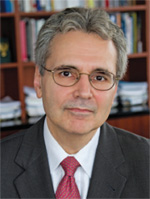
An ambitious plan for curing cancer in a businesslike way is in the works
RON DEPINHO is a man on a mission. Oddly, though, he does not yet know exactly what that mission is. Dr DePinho is the new president of the MD Anderson Cancer Centre in Houston, Texas. (He took over in September, having previously headed the Belfer Institute, part of Harvard’s Dana-Farber Cancer Institute.) Mindful of his adopted city’s most famous scientific role, as home to Mission Control for the Apollo project, he says his own mission is akin to a moon shot. He aims to cure not one but five varieties of cancer. What he has not yet decided is: which five?
That it is possible to talk of curing even one sort of cancer is largely thanks to an outfit called the International Cancer Genome Consortium. Researchers belonging to this group, which involves 39 projects in four continents, are using high-throughput DNA-sequencing to examine 50 sorts of tumour. They are comparing the mutations in many examples of each type, to find which are common to a type (and thus, presumably, causative) and which are mere accidents. (The DNA-repair apparatus in malignant cells often goes wrong, so such accidents are common.)
The consortium’s work is progressing fast, and preliminary results for many tumours are already in. But such knowledge is useless unless it can be translated into treatment. That is where Dr DePinho comes in—for his career has taken him into the boardroom as well as the clinic. He is a serial entrepreneur: he helped found Aveo Pharmaceuticals, which is developing a drug to block the growth of blood vessels in tumours, Metamark Genetics, which works on diagnosing cancers, and Karyopharm Therapeutics, which is trying to regulate the passage of molecules into and out of the cell nucleus, and thus control the nucleus’s activities. His aim in coming to MD Anderson, he says, is to “industrialise” other aspects of biological research in the way that genetics has been pushed forward by high-throughput sequencing.
That will cost billions of dollars. Fortunately, the state of Texas—no pushover when it comes to spending taxpayers’ cash—is creating a $3 billion cancer-research fund to help pay for it. Local philanthropists, including T. Boone Pickens and Ross Perot, are chipping in, too. Their model is the original Human Genome Project, during which the cost of sequencing a single genetic “letter” (a DNA base pair) fell from $10 in 1991 to ten cents in 2001—and is now 3,000 base pairs a cent. They hope their dollars will encourage people working with what are now, essentially, craft technologies to think about how they might industrialise them.
Several techniques look ripe for such industrialisation. Dr DePinho sets great store, for example, by the use of genetically modified mice (he calls them “little patients”) in which mutations found in human cancers can be replicated precisely, but one at a time, to discover the shape of each piece of the jigsaw. If this process can be scaled up it will, as he puts it, allow cancer’s genetic generals to be distinguished from the foot soldiers.
Another field that has great potential is imaging technology—in particular, a combination of positron-emission tomography (which uses radioactive sugar to measure how metabolically active tissue is) and computerised tomography (which uses X-rays to map the body’s internal anatomy). Together these can show whether a treatment is reducing a cancer’s energy consumption, and thus its metabolism. This gives a good indication of how well that treatment is working.
A family business
Dr DePinho himself will have more duties at MD Anderson than just dealing with the five chosen tumours. The donkey work of creating the Institute for Applied Cancer Science, as the new mission control is to be known, will be done by Lynda Chin. Dr Chin, too, worked at the Belfer Institute. She is part of the International Scientific Steering Committee of the cancer-genome project. And she is also Dr DePinho’s wife. Dr Chin will be assisted by some 55 other scientists from the Belfer, who are making the journey to Texas with her and her husband. That sort of team poaching is common in investment banking but rarer in academic research. Dr DePinho refers to it, jokingly, as metastasis, since a clone of his primary creation will be taking root elsewhere in the country.
As to which five cancers to attack, that decision will be made by the middle of 2012. A crucial consideration will be how likely it looks that research into the tumour in question could get rapidly to the “proof of concept” stage—the point at which it could be taken forward by a business that relied on commercial sources of capital, rather than on the sorts of grants that usually propel academic research. At that moment a new firm might be spun out of the institute, or a deal might be done with an established pharmaceutical firm, to try to get a new drug developed.
In recent years many big drug companies have gutted their research departments. This is partly because those departments have failed to come up with new “blockbuster” drugs of the sort that created Big Pharma in the first place, and partly because the big firms’ bosses had hoped that smaller biotechnology companies, of the sort Dr DePinho has helped set up, would do the hard work of drug discovery instead, and then let themselves be bought by the big firms.
Bookmark this page for “cancer revolution” and check back regularly as these articles update on a frequent basis. The view is set to “news”. Try clicking on “video” and “2” for more articles.







